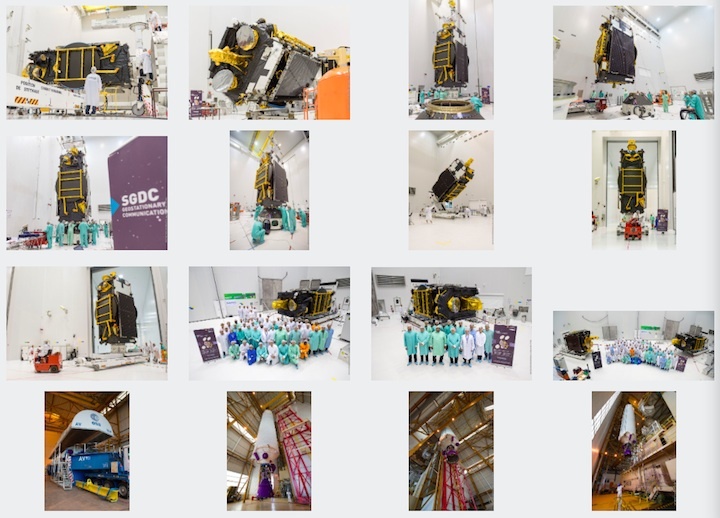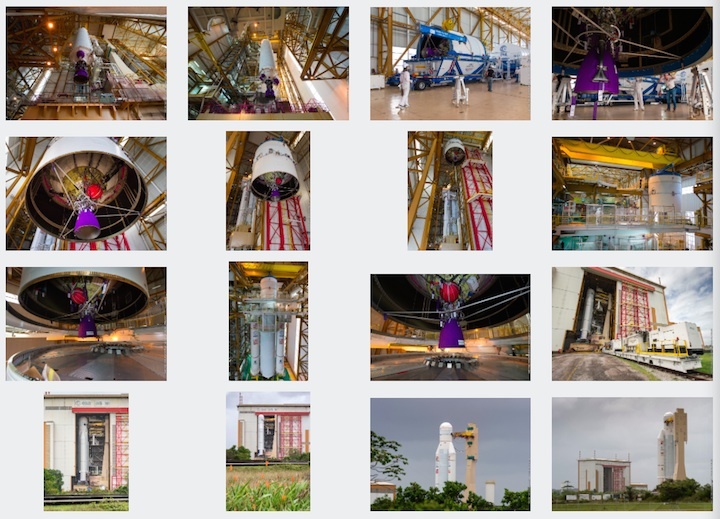17.03.2017
Payload integration underway for Arianespace’s Ariane 5 mission with the SGDC and KOREASAT-7 satellites

The Ariane 5 for Flight VA236 is transferred to the Spaceport’s Final Integration Building, where it is being fitted with the SGDC and KOREASAT-7 satellite payloads.
Maintaining Arianespace’s sustained launch pace in 2017, activity is continuing for the company’s next flight – an Ariane 5 dual-payload mission on March 21 with the SGDC and KOREASAT-7 telecommunications satellites, to be performed from the Spaceport in French Guiana.
The heavy-lift vehicle was delivered to Arianespace earlier this month by production prime contractor Airbus Safran Launchers, with the Ariane 5’s transfer from the Spaceport’s Launcher Integration Building – where it underwent the basic buildup – to the Final Assembly Building for integration of its two payloads.
In parallel, the two satellites have been progressing through their own pre-flight preparations, with both now in the Final Assembly Building. As the mission’s upper payload, SGDC was installed on Ariane 5’s SYLDA dispenser system, and then encapsulated in a long version of the launcher’s ogive-shaped payload fairing. Separately, KOREASAT-7 was integrated atop Ariane 5, to be followed by positioning of the SGDC/SYLDA/payload fairing combination atop it.
Flight VA236: Arianespace’s fourth mission in 2017
The Ariane 5 mission with SGDC and KOREASAT-7 will be Arianespace’s second flight during the month of March, and its fourth so far in 2017. Designated Flight VA236, it follows the year-opening launches of a lightweight Vega on March 6 with the Sentinel-2B Earth observation spacecraft, the February 14 mission using an Ariane 5 to orbit the SKY Brasil-1 and Telkom 3S relay satellites, and January 27’s launch of a medium-lift Soyuz to orbit the Hispasat 36W-1 telecommunications platform.

During integration activity in the Spaceport’s Final Assembly Building, Ariane 5’s payload fairing is lowered into position over the SGDC satellite, which is installed on the SYLDA dispenser (photo at left). In the photo at right, KOREASAT-7 is secured atop Ariane 5’s core section.
Both satellites for Flight VA236 were built by Thales Alenia Space, with the mission’s total payload lift performance set at 10,289 kg. to geostationary transfer orbit.
SGDC is the first Brazilian government satellite, as well as the initial spacecraft to be launched by Arianespace for Visiona Tecnologia Espacial S.A. – the SGDC prime contractor, responsible for the program management, overall system integration and end-to-end communication. This dual-use (civil and military) relay platform will enable the implementation of a secure satellite communications system for the Brazilian government and armed forces, while also reducing the digital divide in Brazil.
The SGDC spacecraft will be operated and controlled by Telebras, a Brazilian telecommunication company managed by the Ministry of Science, Technology, Innovation and Communication.
Spacebus platforms for Flight VA236’s two satellite payloads
Based on the Spacebus 4000C4 platform, the SGDC platform carries 57 transponders in Ka- and X-band. It will have a liftoff mass estimated at 5,735 kg., and is to be positioned at an orbital slot of 75 deg. West.
The KOREASAT-7 passenger on Flight VA236 is designed to provide improved throughput and wider coverage over Korea, Philippines, Indochina, India, and Indonesia. Equipped with Ku-band and Ka-band transponders, it will have a liftoff mass of approximately 3,680 kg. and is built on an upgraded Spacebus 4000B2 platform. The satellite’s added steerable Ka-band capacity is designed to support further demand in relay services.
Once in its orbital slot of 116 deg. East, KOREASAT-7 will be operated by KT SAT – a wholly-owned subsidiary of KT Corp., which is the largest telecom/media service provider in South Korea and the country’s sole satellite service provider.
+++
MISSION
DESCRIPTION
For its fourth launch of the year, and the second Ariane 5 mission in 2017 from the Guiana Space Center in French Guiana, Arianespace will orbit two satellites: SGDC for VISIONA Tecnologia Espacial S.A. on behalf of the Brazilian operator Telebras S.A., and KOREASAT-7 for ktsat of South Korea.
SGDC and KOREASAT-7 are the 555th and 556th satellites to be launched by Arianespace.
This will be the 287th mission by the Arianespace family of launchers, and the seventh all-Thales Alenia Space mission, as both satellites were built by this manufacturer.
- KOUROU
- BETWEEN 5:31 P.M. AND 8:20 P.M. (MAR. 21)
- WASHINGTON D.C.
- BETWEEN 4:31 P.M. AND 7:20 P.M. (MAR. 21)
- UNIVERSAL TIME (UTC)
- BETWEEN 20:31 AND 23:20 (MAR. 21)
- PARIS
- BETWEEN 21:31 P.M. AND 00:20 P.M. (MAR. 21/22)
PAYLOADS
- SGDC
-

SGDC (Geostationary Satellite for Communications and Defense) is the first satellite for the operator Telebras S.A. to be launched by Arianespace, performed within the scope of a contract with SGDC prime contractor VISIONA Tecnologia Espacial S.A.
This Brazilian government program has three main objectives:
- Reduce Brazil’s digital divide by providing high-quality Internet services to 100% of the country territory as part of the National Broadband Plan
- Provide sovereign and secure means for the Brazilian Government and Defense strategic communications
- Acquire critical technologies for the Brazilian space industry, enabling the industry to take increasingly important roles in the future Brazilian space programs.
Positioned at 75° West, with its 57 Ka-band beams and 5 X-band channels, the SGDC is a multi-spot beam HTS satellite able to delivering more than 57 Gbps over the Brazilian territory.
The SGDC will be operated and controlled by Telebras S.A., a Brazilian telecommunication company controlled by the Ministry of Science, Technology, Innovation and Communication; and the Defense Ministry.
As SGDC prime contractor, VISIONA Tecnologia Espacial S.A. is responsible for program management, overall system integration and end-to-end communication. SGDC was manufactured by Thales Alenia Space in Cannes, France using the reliable Spacebus 4000C4 platform.
- KOREASAT-7
-

KOREASAT-7 is the third KOREASAT satellite to be launched by Arianespace for ktsat, following KOREASAT-3 and KOREASAT-6, launched in September 1999 and December 2010, respectively.
ktsat, a wholly-owned subsidiary of KT Corp. – the largest telecom/media service provider in South Korea – is the country’s sole satellite service provider. Since the establishment of the Kumsan Satellite Center (Teleport) in 1970, ktsat has been the national leader in telecommunications and broadcasting services. It currently operates three satellites.
KOREASAT-7 will provide a full range of video and data applications, including Internet access, direct-to-home broadcasting (DTH), government communications and connectivity for VSAT (Very Small Aperture Terminal) networks.
Positioned at 116° East, KOREASAT-7 is designed to provide higher throughput and extended coverage over Korea, the Philippines, the Indochinese Peninsula, India and Indonesia. Its added Ka-band capacity, with steerable beams, will enable it to meet increased demand.
KOREASAT-7 was built by Thales Alenia Space in Toulouse and Cannes, France, using a Spacebus 4000B2 platform.
Quelle: arianespace
---
Update: 20.03.2017
.
Arianespace VA236: Launch delay
Due to a social movement, it was not possible to carry out today’s scheduled transfer of the launch vehicle from the Spaceport’s Final Assembly Building (BAF) to the launch zone.
As a result, Arianespace has decided to postpone the transfer by 24 hours, with operations resuming tomorrow, Tuesday, March 21, 2017, if the situation permits.
The launch vehicle, as well as its SGDC and KOREASAT-7 satellite payloads, have been placed in a stand-by mode and are being maintained in fully safe conditions.
Arianespace Flight VA236 – which is scheduled to launch SGDC for Telebras S.A., performed within the framework of a contract with SGDC prime contractor VISIONA Tecnologia Espacial S.A.; and KOREASAT-7 for ktsat – is now scheduled for:
Wednesday, March 22, 2017 as early as possible within the following launch window:
- Between 4:31 p.m. and 7:20 p.m., Washington D.C. time
- Between 5:31 p.m. and 8:20 p.m., Kourou time in French Guiana
- Between 5:31 p.m. and 8:20 p.m., Brasilia time
- Between 20:31 and 23:20, Universal Time (UTC)
- Between 21:31 p.m. and 00:20 p.m., Paris time during the night of March 22 to 23
- Between 5:31 a.m. and 8:20 a.m., Seoul Time, South Korea, on March 23
- -
Quelle: arianespace
---
Update: 21.03.2017
.
The Ariane 5 mission with SGDC and KOREASAT-7 is rescheduled for March 23
Arianespace’s second Ariane 5 launch of 2017 has been rescheduled for March 23, as continuation of the social movement in French Guiana has prevented today’s transfer of the heavy-lift vehicle to its ELA-3 launch zone.
If the situation permits, the mission – designated Flight VA236 in Arianespace’s numbering system – will lift off on March 23 as early as possible within the following window:
- Between 4:31 p.m. and 7:20 p.m., Washington D.C. time
- Between 5:31 p.m. and 8:20 p.m., Kourou time in French Guiana
- Between 5:31 p.m. and 8:20 p.m., Brasilia time
- Between 20:31 and 23:20, Universal Time (UTC)
- Between 21:31 p.m. and 00:20 p.m., Paris time during the night of March 23 to 24
- Between 5:31 a.m. and 8:20 a.m., Seoul Time, South Korea, on March 24.
The Ariane 5 launcher, with its SGDC and KOREASAT-7 satellite payloads, remain in a stand-by mode and are being maintained in fully safe conditions.
Quelle: arianespace
---
Update: 23.03.2017
.
Arianespace VA236: launch delay
The evolution of the situation does not permit the restart of operations for the Ariane 5 launch scheduled for today, Thursday, March 23, Arianespace has decided to postpone the launch.
The launch vehicle, with its SGDC and KOREASAT-7 satellite payloads, remain in a stand-by mode and are being maintained in fully safe conditions.
Arianespace Flight VA236 – which is scheduled to launch SGDC for Telebras S.A., performed within the framework of a contract with SGDC prime contractor VISIONA Tecnologia Espacial S.A.; and KOREASAT-7 for ktsat.
Quelle: arianespace
---
Update: 4.04.2017
.
Arianespace still shut down at Devil’s Island
The French government has reportedly promised French Guiana a special payment of $4 billion if the region’s strikers end their protest actions. The national strike has closed down all activity at the French-owned spaceport at Kourou and the former prison of Devil’s Island.
Two French minsters of state flew to Cayenne last week with the promise of extra cash, well over the normal budget spend of some €430 million over the five-year budget period.
Matthias Fekl, a minister of the interior, and Ericka Bareigts, the minister for overseas territories, proposed a “pact” whereby the proposed €4 billion would be spent over the course of the next 10 years. Current spending in French Guiana (per head of population) is 44 per cent less than in mainland France, while the cost of living is 12 per cent higher.Last week, more than 10,000 protesters marched in Cayenne to protest over the poor quality of life in the French department. Schools were closed, flights from the international airport and rocket launches from the European spaceport remain cancelled, and movement in the territory was halted by regular roadblocks.
Few doubt that more needs to be done. The population of some 250,000 suffers a very high unemployment rate (40 per cent of Guianese between the age of 15 and 24 are unemployed, and more than a quarter of them have difficulties in reading and writing, compared to 4 per cent in European France).
And during this civil unrest the Ariane launch routine has been badly damaged. Two satellites (for Brazil and Korea) are sitting atop an Ariane rocket, patiently awaiting a clearance to launch. Their two-week delay has a knock-on effect for equally patient Eutelsat and SES satellites.Quelle: ADVANCED TELEVISION
---
Update: 8.04.2017
.
No end in sight for French spaceport strike
The widespread labour strike in French Guiana shows no sign of ending. The action has forced rocket company Arianespace to suspend all work at the spaceport. The strike started on March 20th and now is more or less total with numerous road-blocks affecting all trade in the French colony.
Some 37 labour unions are supporting the strike which went widespread on March27, and with the unions demanding supporting payments from the French Government of €3 billion to aid the local struggling economy.
French Guiana was once ‘Devil’s Island’ and used as a penal colony for some 100 years.
The strikes mean that Arianespace’s launch routines are now severely impacted. Two satellites are currently in storage at the Kourou facility while satellites for Eutelsat, SES and ViaSat are having their launch expectations delayed.
An emergency transfer of €1 billion is reported to have been approved by the French government and this move helped the strikers occupying the main suite of administrative offices at the spaceport to disperse. But the protestors want far more, including new hospitals, better education facilities and health care.Quelle: ADVANCED TELEVISION
---
Update: 27.04.2017
.
Flight VA236 preparations mark the restart of Spaceport launch operations
The Spaceport in French Guiana has resumed its pace for Arianespace’s busy 2017 mission manifest, with operations recommencing for the three subsequent launches – using two Ariane 5s and one Soyuz.

Next up is Flight VA236, set for May 4, to loft two spacecraft: SGDC for VISIONA Tecnologia Espacial S.A. on behalf of the Brazilian operator Telebras S.A., and KOREASAT-7 for South Korean operator ktsat.
SGDC has a liftoff mass estimated at 5,735 kg. and is the mission’s upper passenger. Riding in the lower passenger position is KOREASAT-7, with a mass at liftoff of approximately 3,680 kg.
A pair of Thales Alenia Space-built satellites on Flight VA236
For this fourth Arianespace mission of 2017, both payloads are based on Thales Alenia Space’s Spacebus series of satellite platforms.
Once operation at an orbital position of 75 deg. West with Ka- and X-band transponders, the dual-use SGDC will provide sovereign and secure means for Brazilian government and defense strategic communications, as well as high-quality Internet services to all of the Brazilian territory as part of the National Broadband Plan.
KOREASAT-7 is to be positioned at 116 deg. East, providing a full range of video and data applications – including Internet access, direct-to-home broadcasting (DTH), government communications and connectivity for VSAT (Very Small Aperture Terminal) networks. Its coverage area encompasses Korea, the Philippines, the Indochinese Peninsula, India and Indonesia.
Quelle: arianespace
---
Update: 1.05.2017
.
Visiona Tecnologia Espacial Brasil







---


